[COVID-19] To help mitigate COVID’s impact on architecture firms, Kolau is waiving the fee to create a FORBES Award-Winning website with e-commerce enabled.
Create your website quickly and easily clicking here – Offer available for a limited time only.
Whether you’re a freelance architect or you work in a small architecture firm, you’re probably familiar with the stress that comes about when there are no new projects on the horizon. A steady workflow can help alleviate this stress, but that depends on a good marketing campaign that keeps customers knocking on your door and helps establish the firm’s brand name. To help you generate business and keep stress at bay, four useful marketing strategies for architects have been identified and analyzed here.
The demand for architectural services is related to the volume of residential and commercial construction in an area. With architecture firms usually being small entities and costs being mostly fixed, the economy of scale in the industry is low, making profitability dependent on a continuous inflow of work. This means the industry is highly fragmented creating a good environment for competition and, therefore, hardcore marketing opportunities.

In a fragmented sector, you’ll have hundreds of competitors, but most will be small and weak so they won’t be a significant threat to your development. With that, you have a good opportunity to figure out what makes you different and consolidate your company using that information. These four marketing strategies can help you stand out in the architecture market and help keep a steady influx of projects.
#1 Design Your Marketing Plan Based on the Buying Segments
You may have tried to promote your architecture studio or your services as a freelance architect through paid advertising in the press, search engines or via social media without so much as one phone call or email in response to your efforts. You may feel like you’ve thrown away money and that advertising isn’t useful for architects. However, this isn’t the case.
Typical advertising used by architecture firms tend to focus on one objective: getting hired by a client. While the idea to make an immediate sale isn’t wrong, you’re actually limiting your marketing potential by focusing on only one segment of the population.
Experts agree that only 3 percent of your target is willing to hire your services immediately. There is a purchase cycle that your target goes through before deciding to hire you. You have to take this multi-phased cycle into account and design your marketing strategy as an architect based on it.
Jeremy Miller, brand strategist and author of the best seller Sticky Branding: 12.5 Principles to Stand Out, Attract Customers, and Grow an Incredible Brand, talks about the 3 percent rule. According to Miller, this rule divides your market into five buying segments:
- 3 percent are active buyers. They have a need, they look for options and they want to hire an architect in the next 30-90 days.
- 7 percent are open to the idea of hiring your services but aren’t looking for options actively. A good marketing campaign or a cold call can be effective to pique their interest.
- 30 percent have a need, but it’s not strong enough to act on. They may look like potential customers, but they will not commit as they have other priorities.
- 30 percent don’t have a need. They don’t need your services and they are not receptive to any advertising messages.
- 30 percent aren’t interested in your company. They don’t fit with your brand and they’ll never choose you. They may be loyal to the competition, have had a bad experience with your company, or prefer to use alternative options.
Miller concludes that this rule shows us that there are two types of marketing: active inbound marketing that focuses on the 10 percent of potential clients that need your services now and a more passive form of marketing that focuses on the remaining 90 percent of the market. Inbound marketing includes techniques like search engine advertising for active buyers while SEO, content marketing and social media marketing are the more passive techniques best for potential clients who aren’t ready to commit to your services.
Believe it or not, the inbound marketing for that 10 percent is the easy part. The key here is to focus on the 90 percent of your target audience and establish and develop a good relationship with them before they are ready to hire your services. This is to ensure that when they do have the need for your services they will look you up first and come across your inbound marketing ads which should prompt them to call you instead of the competition. This is where it can get tricky. How can you build a lasting relationship with these people who don’t yet need your services?
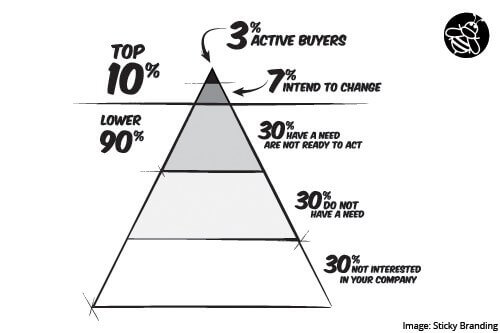
#2 Create Valuable Content for Your Target
Content marketing is one of the best ways to create a relationship with potential clients who don’t yet need your services. According to the Content Marketing Institute,
“Content marketing is a strategic marketing approach focused on the creation and distribution of valuable, relevant and consistent content to attract and retain a clearly defined audience and, ultimately, to drive profitable customer action.”
The keyword here is “valuable.” It’s not about creating content that speaks only about your architecture studio and the services you offer, it’s about creating non-commercial content that adds value for your target, whether educational, informational, entertainment etc.
Since we’re talking about marketing for architects, we recommend using educational content or case studies that show how a client has benefited from your services. According to a Harvard University study, case studies are the type of content that interest buyers the most, especially those in the B2B sector. In fact, it shows an 80 percent completion rate. Here are some ideas:
- Create a blog within your website and publish educational posts that may interest your target audience. Blogging allows you to create educational material that can be shared, build links on your website and help you establish authority in your industry. All of this helps you get leads and improves the SEO of your page. However, before creating any posts, it’s important that you know your target audience well and find the most effective keywords to reach them. Remember that the ideal keywords are those with a high search volume and low competition. You can get this data with tools such as the Keyword planner of Google AdWords. For example, the American firm YR Architecture uses an integrated blog on its website where it shares ideas and tips to modernize your home. They even have a guide on how to choose an architect.
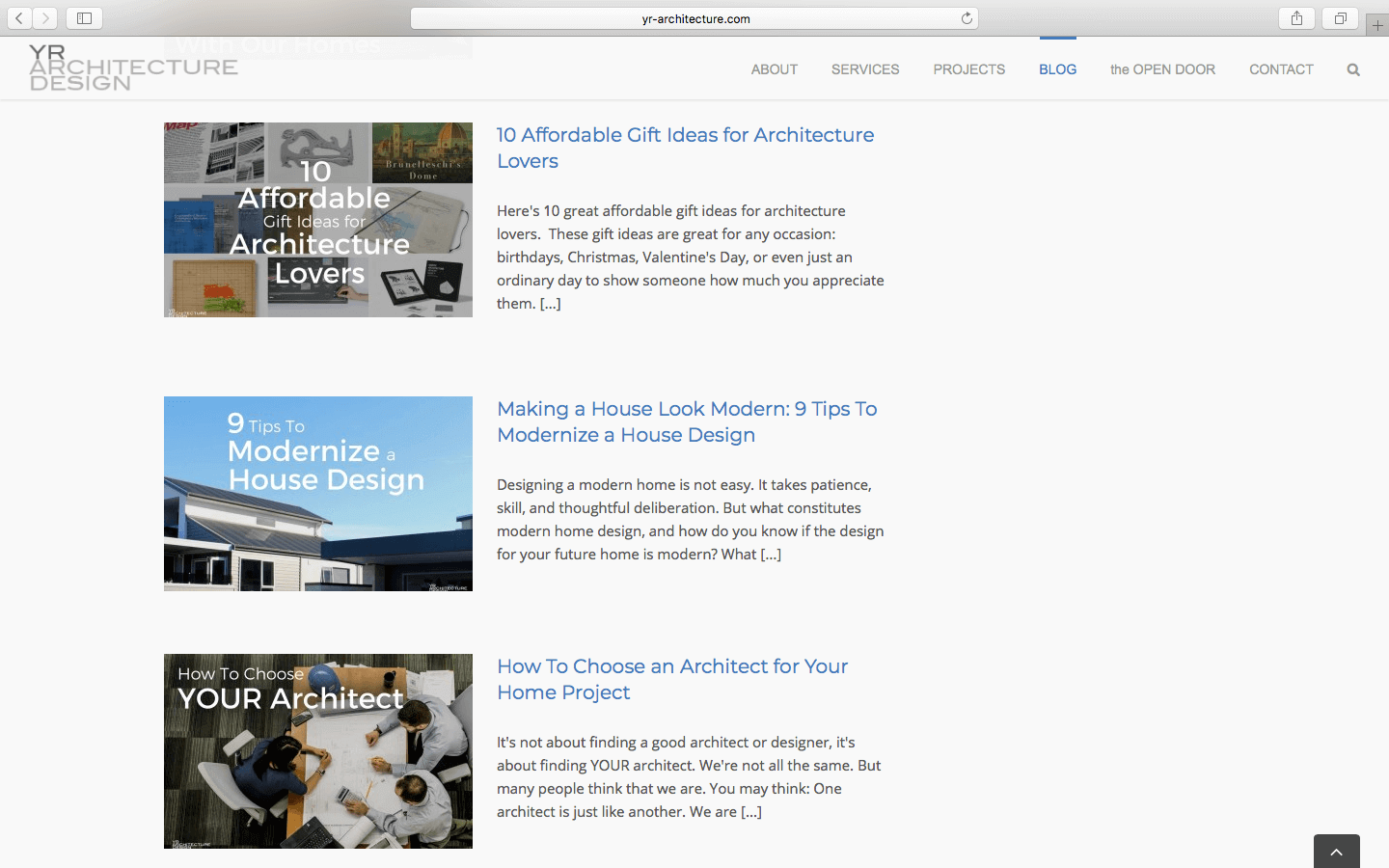
- Create downloadable resources from your website that act as lead magnets. According to a HubSpot study, 70 percent of marketers say converting leads is their top priority. Lead magnets help you do just that. These are pieces of valuable content that users will get in exchange for their email address. In this way, you can stay in contact with them until the need for your services arise and they become your clients. For example, the Canadian architecture company S R Architecture offers a downloadable guide about seven errors to avoid during a restoration through its website.
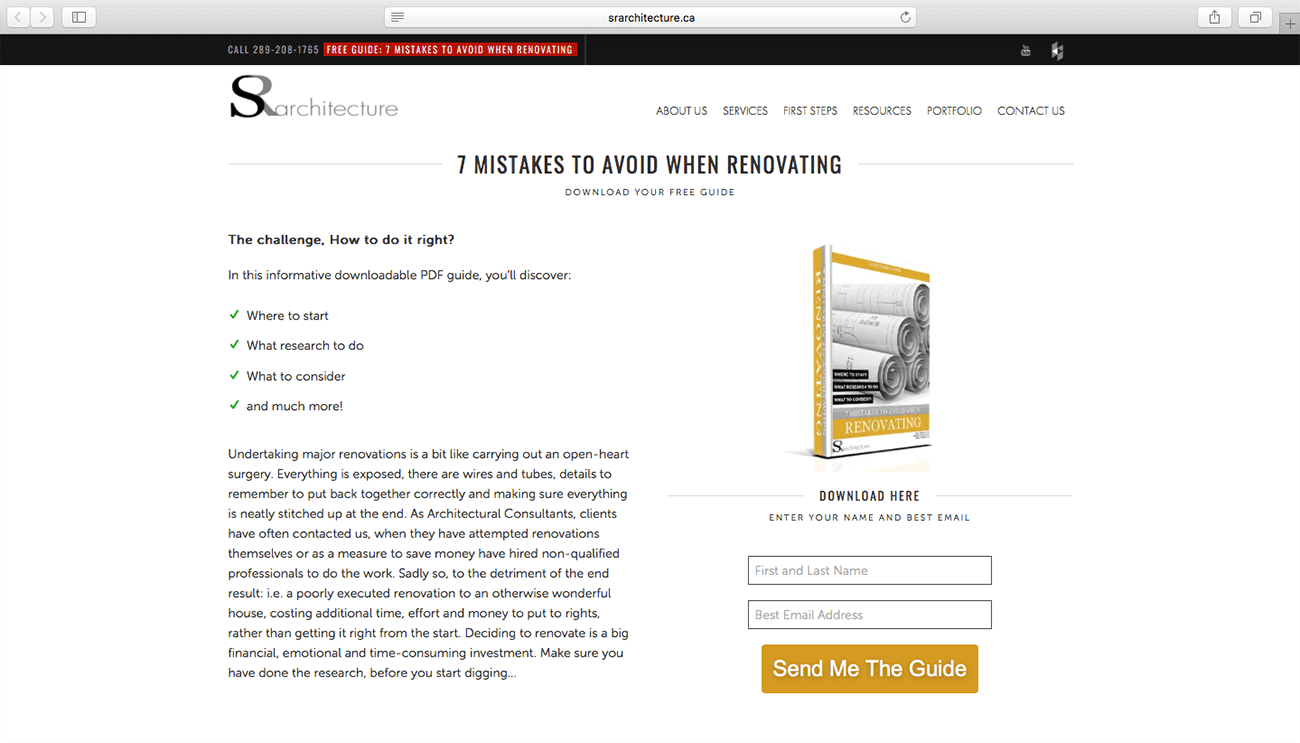
- Design a printed guide aimed at your target with useful information and take it with you to a trade fair, sales convention or any event where you can network. This strategy can help you get leads in person or reach agreements with strategic people to help you get more exposure and visibility. For example, an architect from San Francisco wanted to get more construction projects for optometry offices. To do this, he created a guide to design an optometry office called “8 Step Optometry Office Design Guide.”
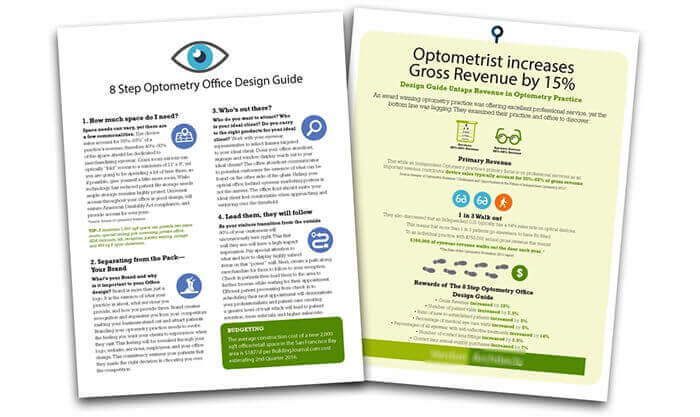
He took this guide to a convention where he addressed two national magazine editors on eyewear and eye care and a speaker of a marketing conference for eyecare professionals. The two editors were so impressed that they asked him to write an article for their upcoming publications and the speaker asked to share the information with his customer database. By creating a useful printed guide, this architect was able to reach his target audience and gain free publicity for his business.
#3 Use the Houzz Platform as a Marketing Tool
Houzz is an online platform focused on design and housing reform. It has more than 40,000 million users throughout 14 countries. It’s a mix between an inspiring search engine, a social media platform, a business directory, a digital scrapbook and a tool to collaborate with customers. That last part is the one we’re interested in since Houzz can act as a nexus between architects and individuals who want to remodel their homes.
In the same way that platforms like TripAdvisor or Yelp help travelers find the ideal vacation spot or restaurant, Houzz can help users who want to remodel their homes find the perfect architect.
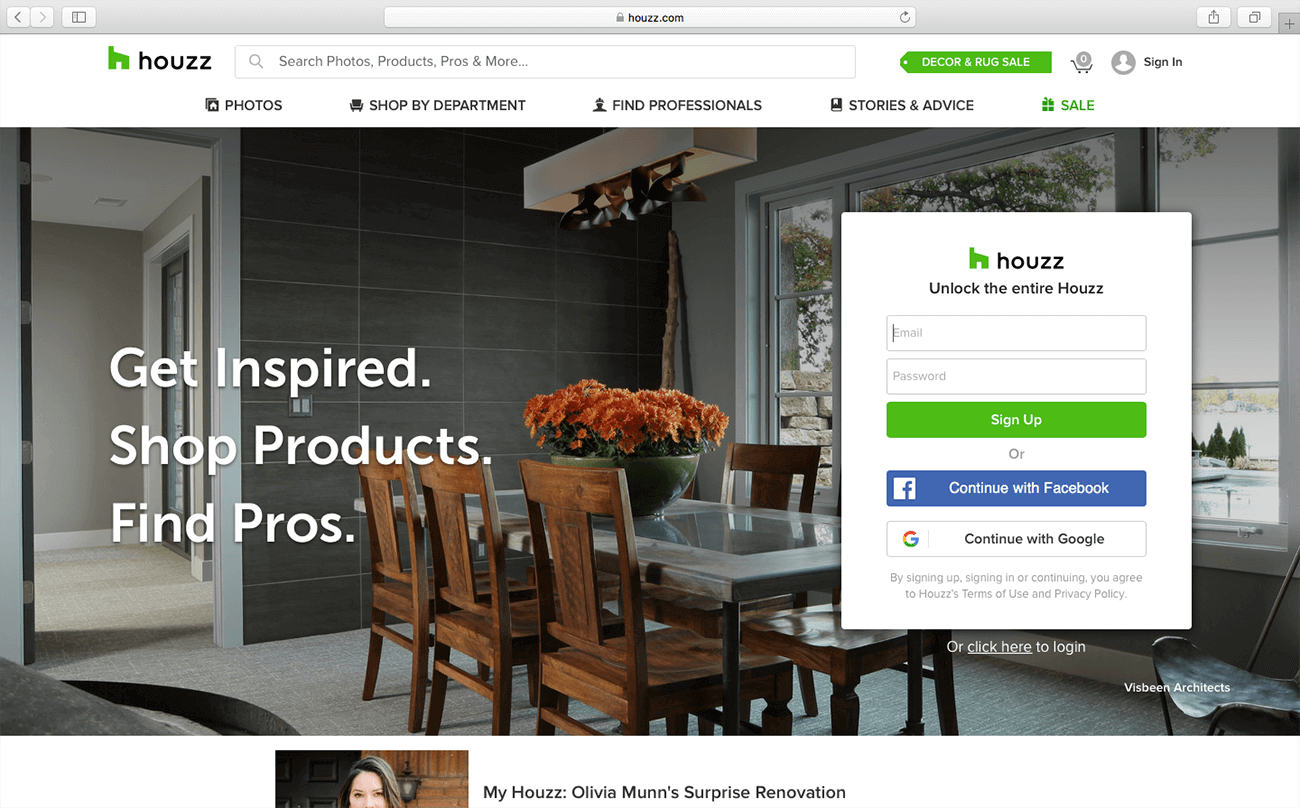
Therefore, it’s a great marketing channel for architects with enormous potential for those who work in residential projects since it allows them to reach their target directly. According to Houzz, 90 percent of their non-professional users are owners and have big plans for the next two years. Out of those users, 84 percent plan to redecorate their house, 40 percent want to remodel and 10 percent want to build a customized home.
Creating a professional profile on Houzz is totally free, too. Here are some tips to get the most out of this platform:
- Upload several high-quality and high-resolution images to your profile and build an excellent portfolio. On Houzz, the visual comes first so the pictures are like your cover letter. Hire a photographer specialized in architecture to photograph your creations and upload the images to the platform organized by project.
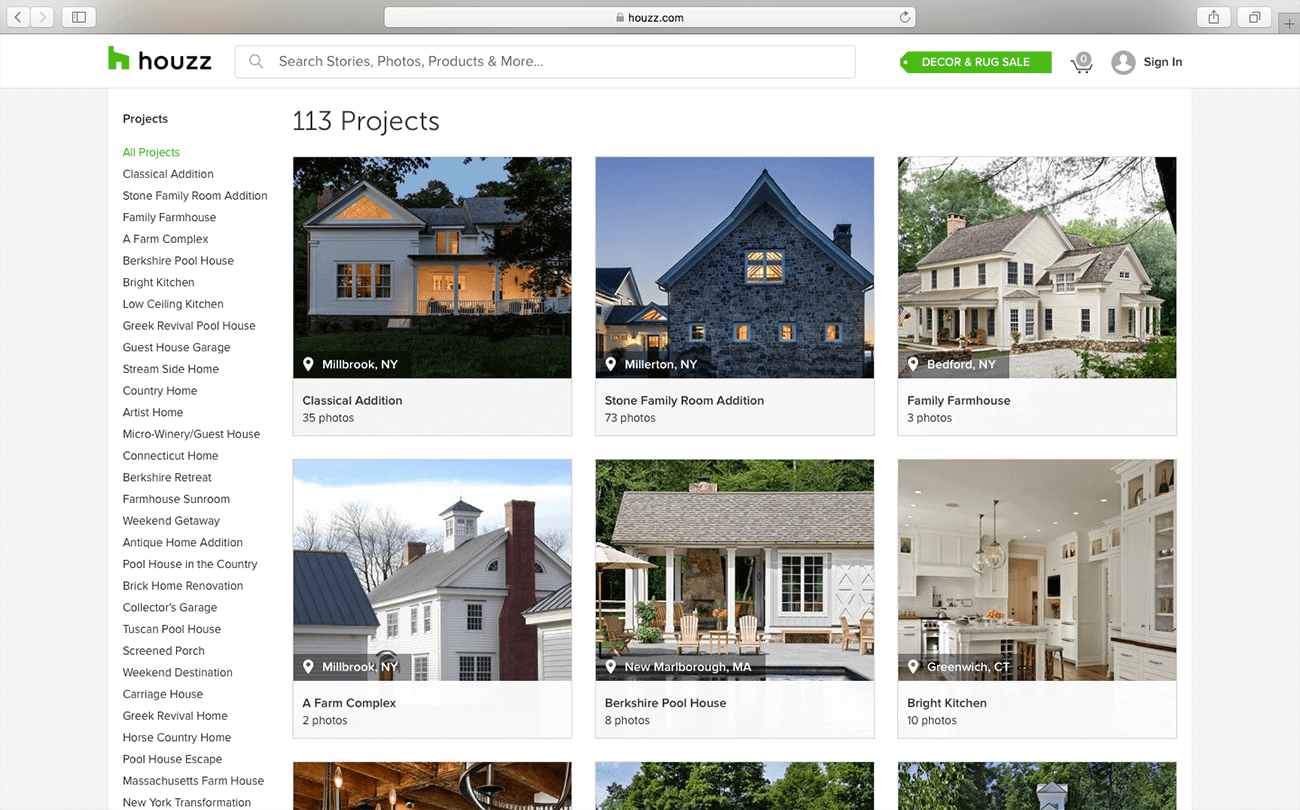
- Add keywords in the titles and descriptions of your photos. In a similar way to Google and Bing, Houzz uses a unique algorithm for its search engine that shows the most relevant professionals for consumer searches. Therefore, the words you use in your profile are what will help users find you. Choose keywords that best describe your services and use them in the descriptions of your photos and in the information section about your company. For example, the firm Crisp Architects works on designing houses with swimming pools and uses the keyword “pool house” in the information section of their company and the description of their photographs. With this, they appear in the first position of searches that include the word “pool house” in the New York area.
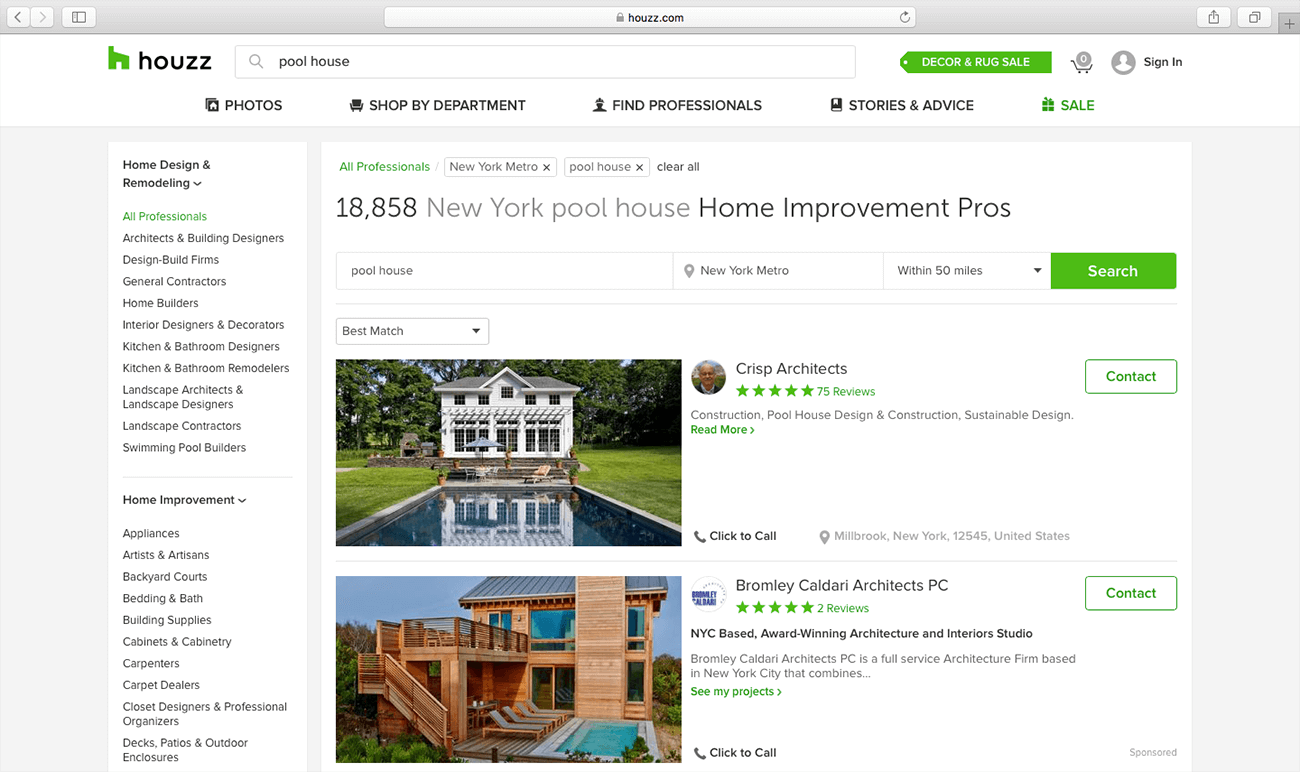
- Stay active on the platform. Houzz openly states that its algorithm also takes into account factors regarding recency and frequency, so try to publish new images often, create ideabooks and interact with the community. You should update your account whenever you complete a project. However, don’t upload all of your images in one day. Instead, upload them little by little. This will keep your profile fresh and will show Houzz that your profile is frequently updated and active.
- Request reviews from your customers. It’s been reported that 92 percent of consumers read reviews when they look for local businesses. Getting numerous reviews from satisfied customers can be a decisive factor since, according to a ReviewTrackers survey, consumers don’t trust companies that show ratings below four stars. Try to request reviews on Houzz from your most loyal customers to minimize the impact of any negative ratings. The platform gives you a specific page to do this.
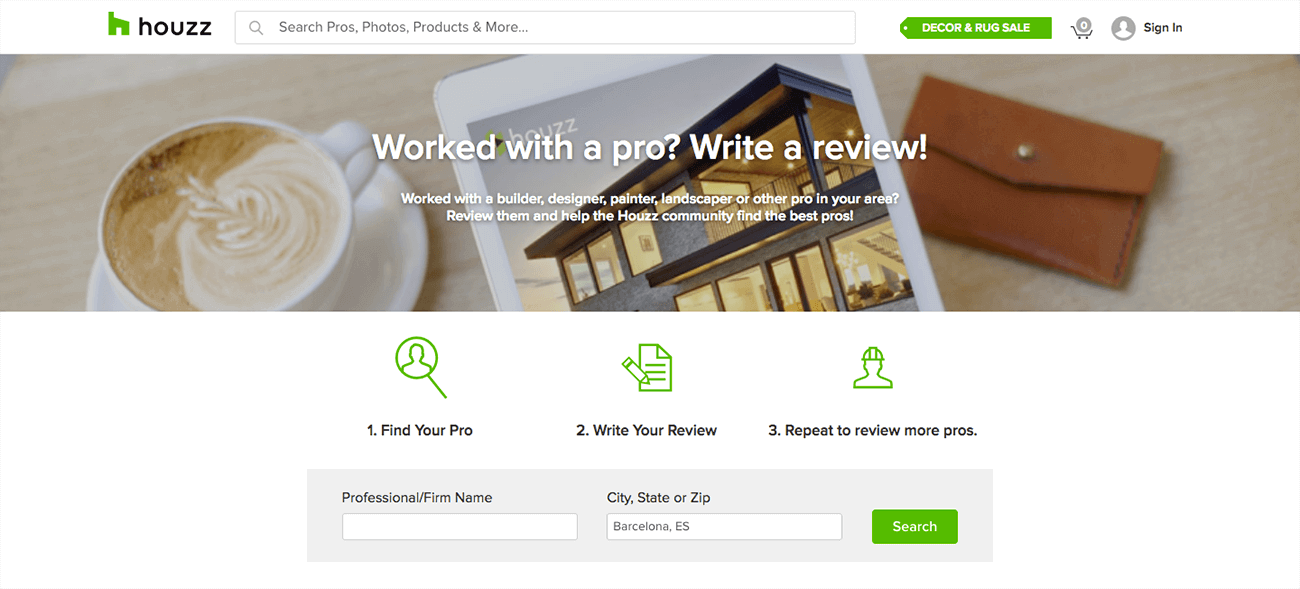
#4 Use Social Media Platforms as an Acquisition Channel
Social media is an excellent channel to gain visibility, generate traffic to your website and to interact with your customers. It’s also one of the cheapest ways to promote your architecture studio. According to Social Media Examiner, 90 percent of professionals say that their efforts on social media platforms have generated more exposure for their businesses, so it’s time to take advantage of this opportunity.
A simple publication on social media platforms can receive likes, be shared/retweeted and generally seen quickly. Before you know it, thousands of people will see your message in a single day. If you manage to create content that fits the interests of your target audience, it’s more likely to be shared giving you even greater brand exposure.
When choosing what social media platforms to use in your marketing strategy as an architect you must take into account two factors, your potential customers use of the platform and the technical capabilities of the platform itself:
- Use the social media platforms that your potential clients use. To figure this out you have to do a little research. Use the search engines on social media platforms to find groups, fan pages or hashtags related to your services. Hopefully, your target audience participates on these pages or follows the hashtags most relevant to your business. If they do, look at the overall size of the community and its activity to assess your scope. If you see that there aren’t a lot of users on that platform, move on. However, if you see that there are active users following related topics, concentrate your marketing efforts on that particular social network.
- The technical abilities of the platform should align with your objectives. If your strategy is aimed at branding and is based on the dissemination of visual and inspiring content, photos and videos will make up the majority of your posts. Instagram and Pinterest could be the most appropriate social media platforms for this. If, on the other hand, you want to focus on sharing useful content from third parties or you are looking to generate traffic to your website, Facebook, Twitter and LinkedIn are better. However, you should be able to implement a useful content strategy for each social media platform. If you don’t have the time or resources to manage them optimally, focus on one or two.
Here are some tips to help you grow your fanbase and make the most of this marketing channel:
- Use a casual tone in your posts. The communication on social media has, by nature, a fun, light and positive tone. This doesn’t mean that every post you publish has to be a joke, it just means that you should aim to be engaging and friendly. Posts that are too formal, serious or distant in tone won’t help you connect with your target audience.
- Humanize your brand through social media. If your architecture company is small and promotes a positive work culture, you can publish pictures of the day-to-day happenings in your studio and the events your workers attend. This will give your brand a human face and convey a sense of closeness with your fans. For example, the small American architectural firm, Payette publishes Instagram photos of its workers and the ping-pong competitions it organizes in its offices.

- Share photos and videos of your projects. As an architect, the visual material generated by your projects can be very attractive and are likely to be shared. Take advantage of this benefit and share high-quality photographs of the construction process of your projects and, above all, of the final result. If you use Instagram, you can even create eye-catching collages that invite your followers to visit your profile to see the full picture, just like Axis Architecture Firm does.
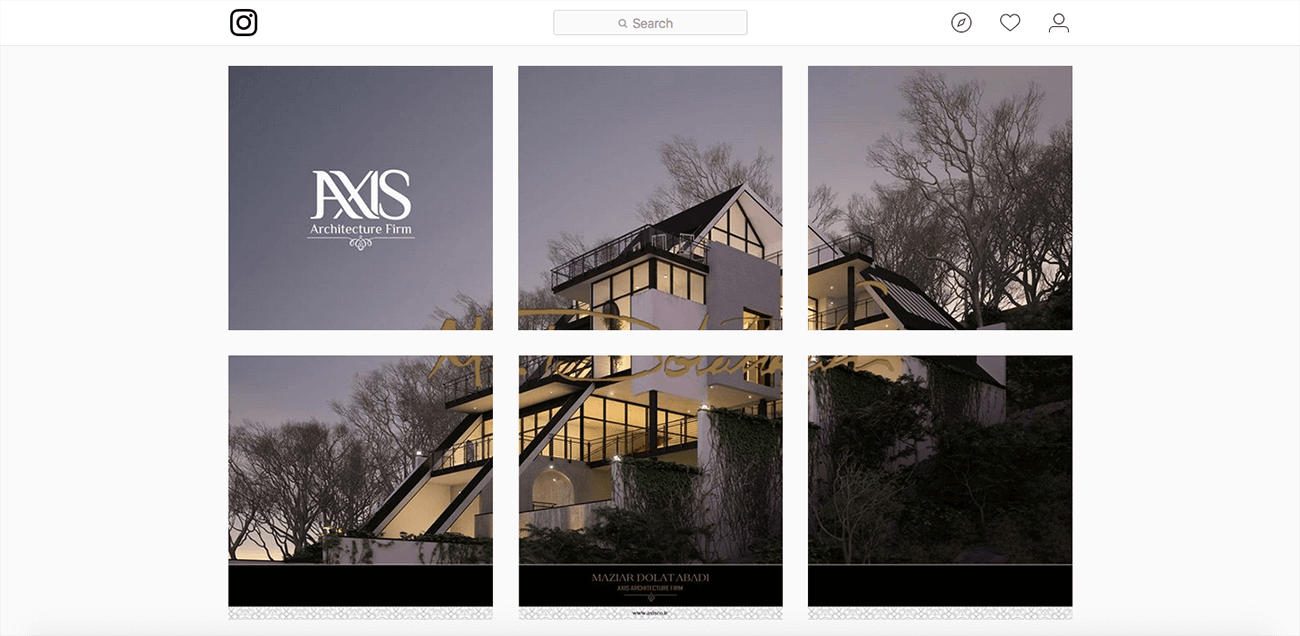
- Use Social Ads to achieve greater relevance in your publications. Paid advertising on Facebook or Linkedin allows you to increase your scope, gain followers and get conversions. Twitter Ads aren’t as good because, as noted in the post 5 Strategies in Social Media for SMEs, advertising on this social media platform doesn’t seem to work. In fact, according to eMarketer, it’s estimated that the popularity of Twitter among US digital marketers will continue to fall by up to 60 percent. On the other hand, Facebook offers very specific segmentation options that let you reach your target not only through demographic and geographical criteria but also through the likes and interests of users and their behavior, among many other things. For example, you could direct your ads to newly married users in your region interested in architectural restoration. It’s likely that this segment is willing to carry out a remodeling job or build a custom house.
Did you find this post useful? If you still want to know more about marketing strategies for architects, you can also take a look at Email Marketing for SMEs.




















